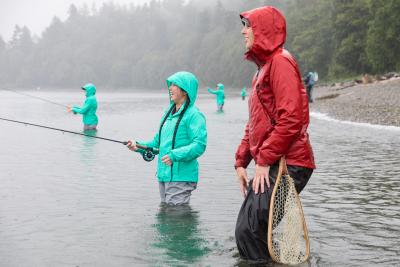Blog


A great opportunity to grow fishing and boating participation lies in engaging women – to get there, we need to start with helping them feel they belong.
Growing female participation in fishing and boating could also lead to recruiting other audiences. In a family, moms are the gateway to the rest of the family. They are more likely to plan activities and manage calendars, even when both parents work full-time. The Recreational Boating & Fishing Foundation (RBFF) found that if the industry grows female participation to male levels, nationwide participation could increase by 26 percent.
Now...Look at any springtime fishing advertisement or simply Google search “fishing” – What do you see? Mainly adult, male participants? A father and son? What you don’t see much of are women, particularly women of color – a big miss for recruitment and retention in fishing and boating participation.
The number of women fishing in the U.S. has steadily risen since 2011. The past decade has seen a 24 percent increase in the number of women who fish each year. For perspective, in 2020, women accounted for nearly two out of every five anglers on the water.
Yet, in 2020, only 11.4 million females considered fishing – the lowest number since 2015, and a decrease of 14 percent since the previous year. Moreover, only 37 percent of those interested in fishing actually participated – the largest gap among any audience type. And female anglers stopped fishing at a 10% higher rate than their male counterparts.
These numbers speak loudly that women are encountering barriers that are keeping them from the water or pushing them away.
To explore what’s beneath the surface, the Recreational Boating & Fishing Foundation partnered with global research firm Ipsos to better understand the mindset and drivers among active, lapsed, and non-angler women and learn what challenges exist to participating in fishing. The research revealed that women face resistance, under-representation, and disrespect in the fishing community.
Fishing is a stereotyped sport. When surveyed, eight out of ten women who fish or have fished stated that ‘when they think of someone who fishes’ – they think of men. Meaning that even those engaged in the sport are acutely aware of their bias.
Marketing perpetuates these views. Look no further than that original springtime fishing advertisement as an example. RBFF’s research found that 75 percent of women do not feel well represented in marketing and advertising related to fishing. A view that can be confirmed - women are not featured as frequently in advertising or marketing as much as men. Avid female anglers from the study used phrases such as ‘unacknowledged’ and ‘do not feel considered’ when they saw fishing advertising.
Women also noted that fishing advertising and marketing only focused on the exciting and competitive side of the sport. While this does lure some women, many seek out fishing for functional and emotional benefits. Fishing improves their mood, brings them peace, helps build confidence and allows them to be their best, relaxed selves.
Fortunately, these marketing challenges are relatively easy to solve. To grow female participation in fishing and boating – it is critical for participants to feel they belong.
State agencies, retailers, and brand products should consider these changes to create a more welcoming entrance point for women:
- Imagery: Try to better represent women and minorities in imagery. Women who see others like themselves are more likely to give it a try. Consider showcasing male and female family and friends enjoying a casual day on the water fishing.
- Fair share: Focus on female professional anglers the same way male professional anglers are highlighted. Professional female anglers are a growing slice of women who fish; many of their accomplishments are on par with male pros. Female pro anglers act as leaders and role models for others. Highlighting them will diversify the spotlight.
- Messaging: Reconfigure the messaging and copy in your marketing to focus on the mental and emotional benefits of fishing. Consider highlighting the potential long-term benefits, mental gains, and bonding experiences of fishing. Highlight that fishing is a relaxing outdoor activity that could be a draw for women who lead hectic, stressful lives.
According to an unrelated Ipsos paper, when advertisements positively portray women, there is an increased likelihood of having a positive impact on a long-term relationship with that brand or activity, as well as short-term behavior change (for both men AND women). Evolving marketing for fishing today could have decades of positive results for the industry.
To learn more about females and fishing, view RBFF’s latest report here. You can also access free, high-resolution imagery depicting a variety of fishing and boating participants and locations here.



